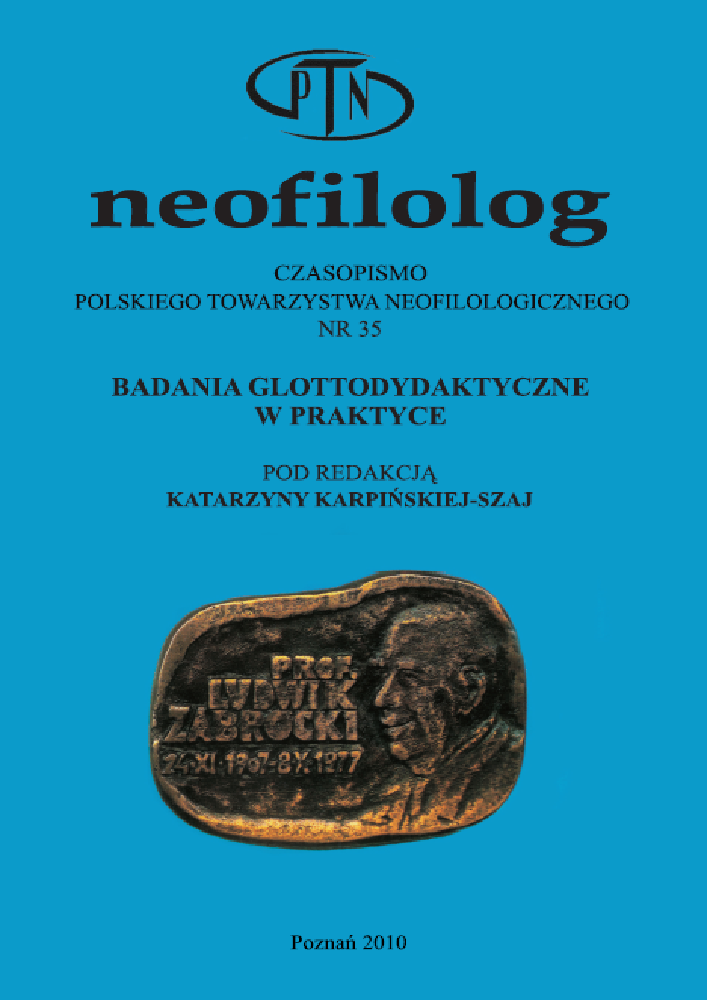Abstrakt
The article presents the results of a quasi-experiment, whose aim was to verify the hypothesis about the advantages of grammatical instruction based on cognitive linguistics principles. Two groups of students took part in a series of lessons, undergoing treatment based either on standard or on cognitive rules concerning the use of English articles. The outcomes of the study demonstrate that although both types of instruction brought positive effects immediately after the treatment, the cognitive group outperformed the traditional group on delayed posttesting.
Bibliografia
Achard, M. i S. Niemeier (red.) 2004. Cognitive Linguistics, Second Language Acquisition and Foreign Language Teaching. New York: Mouton de Gruyter.
Bielak, J. 2007. „Applying cognitive grammar in the classroom: teaching English possessives” (w) M. Pawlak (red.) Exploring Focus on Form in Language Teaching (Special Issue of Studies in Pedagogy and Fine Arts). Poznań: Wydawnictwo Uniwersytetu Adama Mickiewicza. 113-133.
O’Malley i Chamot, A.U. 1990. Learning Strategies in Second Language Acquisition. Cambridge: Cambridge University Press.
Dirven, R. 1986. „Towards a pedagogical English grammar”. (w) G. Leitner (red.) The English Reference Grammar. Language and Linguistics, Writers and Readers. Tübingen: Niemeyer. 89-102.
Dirven, R. 2001. „English phrasal verbs: theory and didactic application”. (w) M Martin Pütz, S. Niemeier i R. Dirven (red.) Applied Cognitive Linguistics. Berlin/New York: Mouton de Gruyter. 3-27.
Eastwood, J. 2005. Oxford Learners’ Grammar. Grammar Finder. Oxford: Oxford University Press.
Ellis, R. 1993. „The structural syllabus and second language acquisition”. TESOL Quarterly 27: 91-113.
Ellis, N.C. 2002. „Reflections on frequency effects in language processing”. Studies in Second Language Acquisition 24: 297-339.
Ellis, N.C. 2005. „At the interface: dynamic interactions of explicit and implicit language knowledge”. Studies in Second Language Acquisition 27: 305-352.
Komorowska, H. 1982. Metody badań empirycznych w glottodydaktyce. Warszawa: PWN.
Król-Markefka, A. 2006. „The effects of applying cognitive grammar into the teaching of English articles to Polish learners”. (w) E. Witalisz i J. Leśniewska (red.): Language and identity: English and American studies in the age of globalisation. Vol. 2: Language and culture. Kraków: Jagiellonian University Press. 100-115.
Król-Markefka, A. 2007. „How do Polish learners use English articles? A diagnostic study”. (w) Pawlak, M. (red.) Exploring Focus on Form in Language Teaching. Kalisz-Poznań: Faculty of Pedagogy and Fine Arts. 135-153.
Kurtyka, A. 2001. „Teaching English phrasal verbs: A cognitive approach”. (w) M. Pütz, S. Niemeier i R. Dirven, (red.) Applied Cognitive Linguistics. Berlin/New York: Mouton de Gruyter. 29-53.
Langacker, R. 1987. Foundations of Cognitive Grammar: Vol I: Theoretical Prerequisites. Stanford: Stanford University Press.
Lewandowska-Tomaszczyk, B. i K. Turewicz 2002. Cognive Lingusitcs Today. Frankfurt/Main: Peter Lang.
McLaughlin, B. 1990. „Restructuring”. Applied Linguistics 11: 113-128.
Murphy, G. 2004. English Grammar in Use. Cambridge: Cambridge University Press.
Norris, J. M., i Ortega, L. 2000. „Effectiveness of L2 instruction: A research synthesis and quantitative meta-analysis”. Language Learning 50: 417-528.
Pawlak, M. 2009. „Nauczanie gramatyki języka obcego – kierunki i metody badań” Neofilolog 32: 33-48.
Perdue, C. (red.) 1993. Adult language acquisition: Crosslinguistic perspectives. New York: Cambridge University Press
Rudzka-Ostyn, B. 2003. Word power: Phrasal Verbs and Compounds. A Cognitive Approach. Berlin/New York: Mouton de Gruyter.
Schmidt, R. 1993. „Awareness and second language acquisition”. Annual Review of Applied Linguistics 13: 206-226.
Swan M. i C. Walter. 1997. How English works. A grammar Practice Book. Oxford: Oxford University Press.
Taylor, J.R. 1993. „Some pedagogical implications of cognitive linguistics”. (w) R.A. Geiger i B. Rudzka-Ostyn (red.) Conceptualizations and Mental Processing in Language. Berlin/New York: Mouton de Gruyter. 201-223.
Turewicz, K. 2000. Applicability of Cognitive Grammar as a Foundation of Pedagogical/Reference Grammar. Łódź: Wydawnictwo Uniwersytetu Łódzkiego.
Wysocka, M. 2000. „Pułapki metodologiczne w projektowaniu badań nad procesem nauczania/uczenia się języka obcego”. (w) J. Arabski (red.) Metody badań glottodydaktycznych. Katowice: Wyższa Szkoła Zarządzania Marketingowego i Języków Obcych. 123-127.
Licencja
Prawa autorskie (c) 2010 Agnieszka Król-Markefka

Utwór dostępny jest na licencji Creative Commons Uznanie autorstwa – Bez utworów zależnych 4.0 Międzynarodowe.
Przedstawiany utwór (artykuł) upubliczniany jest na podstawie umowy z autorem i na licencji Creative Commons Attribution-NoDerivatives 4.0 International (CC BY-ND 4.0).
Użytkownicy mają obowiązek podania wraz z rozpowszechnionym utworem, informacji o autorstwie, tytule, źródle (odnośniki do oryginalnego utworu, DOI) oraz samej licencji;
- bez tworzenia utworów zależnych,
- utwór musi być zachowany w oryginalnej postaci.
Uniwersytet im. Adama Mickiewicza w Poznaniu zachowuje prawo do czasopisma jako całości (układ, forma graficzna, tytuł, projekt okładki, logo itp.).
